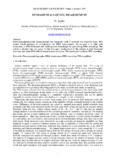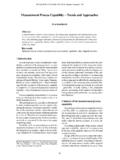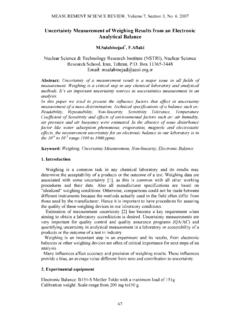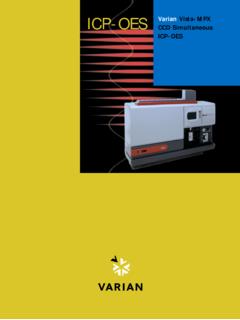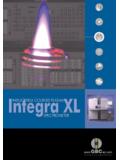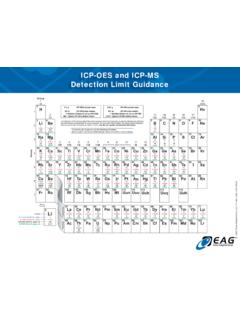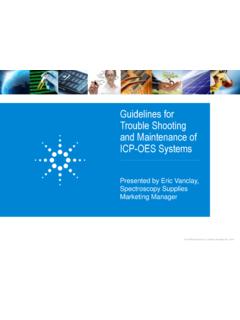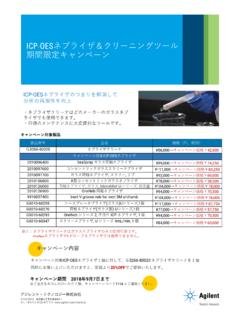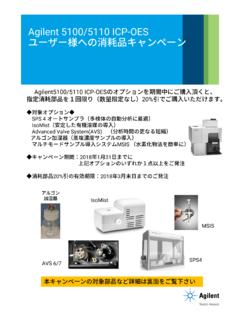Transcription of Uncertainty Estimation for the Determination of Ni, …
1 MEASUREMENT SCIENCE REVIEW, Volume 8, Section 1, No. 6, 2008 151 Uncertainty Estimation for the Determination of Ni, Pb and Al in Natural Water Samples by SPE-ICP-OES A. Ghorbani 1, M. Mahmoodi Farahani2, M. Rabbani3, F. Aflaki4, Syed Waqif hosain5 1 Department of chemistry, Islamic Azad University, Saveh Branch, Saveh, Iran, 2 Department of biostatistics, Tehran Medical Sciences, Tehran, 3 Department of chemistry, Islamic Azad University, North Tehran Branch, Tehran, Iran, 4 Department of chemistry, Islamic Azad University, North Tehran Branch, Tehran, Iran, 5 Department of chemistry, Science and Research Campus, Islamic Azad University, Tehran, Iran, In this paper we propose Uncertainty Estimation for the analytical results we obtained from Determination of Ni, Pb and Al by solid-phase extraction and inductively coupled plasma optical emission spectrometry (SPE-ICP-OES).
2 The procedure is based on the retention of analytes in the form of 8-hydroxyquinoline (8-HQ) complexes on a mini column of XAD-4 resin and subsequent elution with nitric acid. The influence of various analytical parameters including the amount of solid phase, pH, elution factors (concentration and volume of eluting solution), volume of sample solution, and amount of ligand on the extraction efficiency of analytes was investigated. To estimate the Uncertainty of analytical result obtained, we propose assessing trueness by employing spiked sample. Two types of bias are calculated in the assessment of trueness: a proportional bias and a constant bias. We applied Nested design for calculating proportional bias and Youden method to calculate the constant bias. The results we obtained for proportional bias are calculated from spiked samples.
3 In this case, the concentration found is plotted against the concentration added and the slop of standard addition curve is an estimate of the method recovery. Estimated method of average recovery in Karaj river water is: ( ) for Ni, ( ) for Pb and ( ) for Al. Keywords: Solid phase extraction; Amberlite XAD-4; inductively coupled plasma-optical emission spectroscopy (ICP-OES); Uncertainty 1. INTRODUCTION ETERMINATION OF trace metal ions in natural waters is becoming increasingly important because of the increase interest in monitoring environmental pollution. For preconcentration, different procedures such as liquid-liquid extraction, co-precipitation, electro-deposition and solid phase extraction mainly using ionic exchange resins have been developed [1].
4 Among all these procedure solid phase extraction techniques are quite popular since they offer a number of important advantages over other preconcentration methods. One of these benefits is that sorbent material can be packed into mini-columns or cartridges which provide sufficient adsorption capacity for many applications. In solid phase extraction, various sorbents such as activated carbon, octadecyl bonded silica membrane disk, silica-gel, polyurethane foam, chelex 100 and Amberlite XAD resin family have been used for the peconcentration of trace metal ions from various media such as natural water samples, urine, geological samples [2-7]. Amberlite XAD-4 is a polymeric adsorbent with excellent physical, chemical and thermal stability and it is also stable at all pH range in aqueous solutions [8-12].
5 Analytical result must be validating because they are used as a peace of valuable information for a certain aim. Therefore, analysts are increasingly impelled to validate analytical procedures and to estimate the Uncertainty associated to the results these procedures provide. Uncertainty can be obtained either by calculating all the sources of Uncertainty individually (bottom-up approach) or by grouping all sources of Uncertainty . However, the last one is not straightforward; other approaches based on calculating Uncertainty using information from the validation process have been proposed [13-15]. The approach proposed in [14,16,17] can be used when routine samples have similar level of concentration because the bias of analytical procedure is assumed to be constant throughout the concentration range and when the routine samples vary within a range of concentration, trueness should be verified using samples that cover the whole concentration range [14,16].
6 Another protocol proposed by Ellison [15], verify trueness in the terms of method recovery. Therefore, the bias of analytical results is only assumed to be proportional. However, there may be two types of bias (proportional and constant bias). So, another approach proposed by Morato that calculate Uncertainty in wide range of concentration and assume both types of bias may be present. In this approach recovery is estimated with the method of averaged recovery and constant bias with the Youden method [17, 18]. The aim of this study was to develop a Morato method in Uncertainty Estimation of analytical results obtained by assessing trueness and employing spiked samples in Determination of Ni, Pb and Al in river water samples by SPE-ICP-OES. 2. EXPERIMENTAL SECTION Instrumentation An Optima 2100 DV inductively coupled plasma optical emission spectrometer (Perkin Elmer Instruments, Shelton, CT, USA) was used for metal Determination .
7 The operation conditions and the analytical wavelengths are summarized in Sample solution was driven through the columns with a D MEASUREMENT SCIENCE REVIEW, Volume 8, Section 1, No. 6, 2008 152multi-channel Heidolph PD 5001 peristaltic pump. The pH values were controlled with a Mettler Toledo MA235 pH meter (Mettler Toledo Instruments CO. LTD, Shanghai, China) supplied with a combined electrode. A self-made polytetrafluoroethylene (PTFE) mini-column (50 5 mm ), packed with XAD-4, was used for separation/preconcentration. Parameters RF power (watts) Nebulizer gas flow rate (L min-1) Auxiliary gas flow rate (L min-1) Plasma gas flow rate (L min-1) Sample flow Rate (ml min-1) Wavelength (nm) 1300 15 Ni , Pb Al Tab. 1 Instrumental and operating conditions for ICP-OES measurements Chemicals and solutions All chemicals used were of analytical-reagent grade.
8 Deionised water was used throughout. Multi-element standard (various concentrations) and model solution were prepared by dilution of single element 1000 mg l-1 stock solutions. Nitric acid, hydrochloric acid, methanol, sodium acetate, acetic acid ammonia solutions were purchased from Merck. Amberlite XAD-4 (surface area, 750 m2 g-1 and bead size, 20 50 mesh) were obtained from Fluka. Column experiments were performed with micro-particles prepared by crushing XAD-4 resins in a mortar, subsequently sieving into fractions. Fractions were cleaned thoroughly washed in the sequence of mol l-1 NaOH, DI water, mol l-1 HNO3 and DI water. It was finally washed with methanol and dried in the air. 8-HQ (from Fluka) solution ( mol l-1) was prepared in mol l-1 hydrochloric acid.
9 General procedure The performance of proposed column was tested with model solution prior to its application to real water samples. 100 ml of the model solution containing 10 g each of Ni, Pb and Al prepared and 100 l of 8-HQ solution was added to form the metal-complexes. The pH was adjusted to desired value with addition appropriate volume of nitric acid and ammonia solution. The sample solution was passed through a cleaned and conditioned column at a flow rate of ml min-1 by using a peristaltic pump. After loading further washing with buffer solution served to remove any sample still present in the column. Finally, the metal-complexes retained on the mini-column were eluted with mol l-1 nitric acid solution. The eluted trace elements were measured by ICP-OES.
10 The column could be used repeatedly after regeneration with mol l-1 nitric acid solution, DI water, and methanol and DI water, respectively. Sample collection Samples used for the developing of the analytical procedure were collected from Karaj River in the city of Karaj Iran. All samples were collected in pre-cleaned high density polyethylene bottles. Collected samples acidified at pH lower than by adding concentrated nitric acid in order to avoid metal adsorption on to the inner bottles walls, then samples were filtered through a m polycarbonate membranes nucleopore filter. Influence of analytical parameter The influence of various analytical parameters including the amount of solid phase, pH, elution factors (concentration and volume of eluting solution), volume of sample solution, and amount of ligand on the extraction efficiency of analytes was investigated and after finding the optimum situation of analyse, all experiments runs and the Uncertainty of analytical result estimated.
